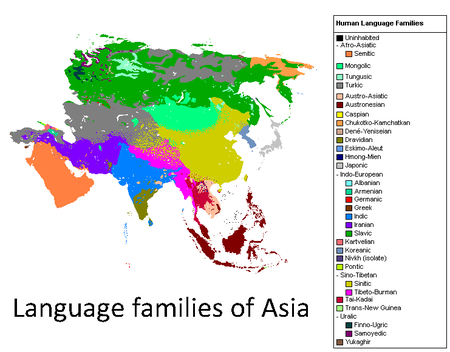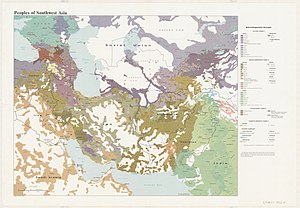Languages of Asia
This article needs additional citations for verification. (December 2016) |

A wide variety of languages are spoken throughout Asia, comprising different language families and some unrelated isolates. The major language families include Austroasiatic, Austronesian, Caucasian, Dravidian, Indo-European, Afroasiatic, Turkic, Sino-Tibetan and Kra–Dai. Most, but not all, have a long history as a written language.
Language groups[]

The major families in terms of numbers are Indo-European and Indo-Aryan languages and Dravidian languages in South Asia and Sino-Tibetan in East Asia. Several other families are regionally dominant.
Sino-Tibetan[]
Sino-Tibetan includes Chinese, Tibetan, Burmese, Karen, Boro and numerous languages of the Tibetan Plateau, southern China, Burma, and North east India.
Indo-European[]
The Indo-European languages are primarily represented by the Indo-Iranian branch. The family includes both Indic languages (Hindi, Urdu, Bengali, Odia, Assamese, Punjabi, Sindhi, Kashmiri, Marathi, Gujarati, Sinhala and other languages spoken primarily in South Asia) and Iranian (Persian, Kurdish, Pashto, Balochi and other languages spoken primarily in Iran, Anatolia, Mesopotamia, Central Asia, the Caucasus and parts of South Asia). In addition, other branches of Indo-European spoken in Asia include the Slavic branch, which includes Russian in Siberia; Greek around the Black Sea; and Armenian; as well as extinct languages such as Hittite of Anatolia and Tocharian of (Chinese) Turkestan.
Altaic families[]
A number of smaller, but important and separately distinguished language families spread across central and northern Asia have long been linked in a hypothetical, controversial and unproven Altaic family. These are the Turkic, Mongolic, Tungusic (including Manchu), Koreanic, and Japonic languages. But recently, it is often considered as Sprachbund by the majority.
Mon–Khmer[]
The Mon–Khmer languages (also known as Austroasiatic) are the language family in South and Southeast Asia. Languages given official status are Vietnamese and Khmer (Cambodian).
Kra–Dai[]
The Kra–Dai languages (also known as Tai-Kadai) are found in southern China, Northeast India and Southeast Asia. Languages given official status are Thai (Siamese) and Lao.
Austronesian[]
The Austronesian languages are widespread throughout Maritime Southeast Asia, including major languages such as Fijian (Fiji), Cebuano, Tagalog (Philippines), and Malay (Malaysia, Singapore, and Brunei). Javanese, Sundanese, and Madurese of Indonesia belong to this family as well.
Dravidian[]
The Dravidian languages of southern Asia (India) and parts of Sri Lanka include Tamil, Kannada, Telugu, and Malayalam, while smaller languages such as Gondi and Brahui are spoken in central India and Pakistan respectively.
Afro-Asiatic[]
The Afroasiatic languages (in older sources Hamito-Semitic) are represented in Asia by the Semitic branch. Semitic languages are spoken in Western Asia, and include Arabic, Hebrew and Aramaic, in addition to extinct languages such as Akkadian.
Siberian families[]
Besides the Altaic families already mentioned (of which Tungusic is today a minor family of Siberia), there are a number of small language families and isolates spoken across northern Asia. These include the Uralic languages of western Siberia (better known for Hungarian and Finnish in Europe), the Yeniseian languages (linked to Turkic and to the Athabaskan languages of North America), Yukaghir, Nivkh of Sakhalin, Ainu of northern Japan, Chukotko-Kamchatkan in easternmost Siberia, and—just barely—Eskimo–Aleut. Some linguists have noted that the Koreanic languages share more similarities with the Paleosiberian languages than with the Altaic languages. The extinct Ruan-ruan language of Mongolia is unclassified, and does not show genetic relationships with any other known language family.
Caucasian families[]
Three small families are spoken in the Caucasus: Kartvelian languages, such as Georgian; Northeast Caucasian (Dagestanian languages), such as Chechen; and Northwest Caucasian, such as Circassian. The latter two may be related to each other. The extinct Hurro-Urartian languages may be related as well.
Small families of Southern Asia[]
Although dominated by major languages and families, there are number of minor families and isolates in South Asia & Southeast Asia. From west to east, these include:
- extinct languages of the Fertile Crescent such as Sumerian and Elamite
- extinct languages of South Asia: the unclassified Harappan language
- small language families and isolates of the Indian subcontinent: Burushaski, Kusunda, and Nihali. The Vedda language of Sri Lanka is likely an isolate that has mixed with Sinhala.
- the two Andamanese language families: Great Andamanese and Ongan; Sentinelese remains undocumented to date, and hence unclassified.
- unclassified languages in Southeast Asia: Kenaboi.
- Language isolates and independent language families in Arunachal: Digaro, Hrusish (including the Miji languages[1]), Midzu, Puroik, Siangic, and Kho-Bwa
- Hmong–Mien (Miao–Yao) scattered across southern China and Southeast Asia
- several "Papuan" families of the central and eastern Malay Archipelago: languages of Halmahera, East Timor, and the extinct Tambora of Sumbawa. Numerous additional families are spoken in Indonesian New Guinea, but this lies outside the scope of an article on Asian languages.
Creoles and pidgins[]
The eponymous pidgin ("business") language developed with European trade in China. Of the many creoles to have developed, the most spoken today are Chavacano, a Spanish-based creole of the Philippines, and various Malay-based creoles such as Manado Malay influenced by Portuguese. A very well-known Portuguese-based creole is the Kristang, which is spoken in Malacca, a city-state in Malaysia.
Sign languages[]
A number of sign languages are spoken throughout Asia. These include the Japanese Sign Language family, Chinese Sign Language, Indo-Pakistani Sign Language, as well as a number of small indigenous sign languages of countries such as Nepal, Thailand, and Vietnam. Many official sign languages are part of the French Sign Language family.
Official languages[]
Asia and Europe are the only two continents where most countries use native languages as their official languages, though English is also widespread as an international language.
| Language | Native name | Speakers | Language family | Official status in a country | Official Status in a region |
|---|---|---|---|---|---|
| Abkhaz | Аԥсшәа | 240,000 | Northwest Caucasian | Abkhazia | |
| Arabic | العَرَبِيَّة | 230,000,000 | Afro-Asiatic | Bahrain Iraq Jordan Kuwait Lebanon Oman Palestine Qatar Saudi Arabia Syria UAE Yemen |
|
| Armenian | հայերեն | 5,902,970 | Indo-European | Armenia Artsakh |
|
| Assamese | অসমীয়া | 15,000,000 | Indo-European | India
| |
| Azerbaijani | Azərbaycanca | 23,000,000 | Turkic | Azerbaijan | |
| Balochi | بلۏچی
Balòči |
7,600,000 | Indo-European | Pakistan
Iran
| |
| Balti | بلتی
སྦལ་ཏི། |
392,800 | Sino-Tibetan | Pakistan
| |
| Bengali | বাংলা | 230,000,000 | Indo-European | Bangladesh | India
|
| Bodo | बर'/बड़ Boro |
1,984,569 | Sino-Tibetan | Nepal
India
| |
| Burmese | မြန်မာဘာသာ | 33,000,000 | Sino-Tibetan | Myanmar | |
| Cantonese | 廣東話/广东话 | 7,877,900 | Sino-Tibetan | China
| |
| Chin | Kukish | 3,000,000 | Sino-Tibetan | Myanmar | |
| Chinese Mandarin | 普通話/普通话 國語/国语 華語/华语 |
1,200,000,000 | Sino-Tibetan | China Singapore |
Hong Kong Macau Taiwan Myanmar |
| Dari | دری | 19,600,000 | Indo-European | Afghanistan | |
| Dhivehi | ދިވެހިބަސް | 400,000 | Indo-European | Maldives | |
| Dzongkha | རྫོང་ཁ་ | 600,000 | Sino-Tibetan | Bhutan | |
| Filipino |
Wikang Filipino |
93,000,000 | Austronesian | Philippines | |
| Formosan | 171,855 | Austronesian | Republic of China
| ||
| Georgian | ქართული | 4,200,000 | Kartvelian | Georgia | |
| Gujarati | ગુજરાતી | 50,000,000 | Indo-European | India
| |
| Hakka | 客家話/客家话 Hak-kâ-fa |
2,370,000 | Sino-Tibetan | Republic of China
| |
| Hebrew | עברית | 7,000,000 | Afro-Asiatic | Israel | |
| Hindi | हिन्दी | 550,000,000 | Indo-European | India | |
| Hokchiu | 馬祖話 Mā-cū-huâ |
12,000 | Sino-Tibetan | Republic of China
| |
| Hokkien | 臺灣話 Tâi-oân-oē |
18,570,000 | Sino-Tibetan | Republic of China
| |
| Indonesian | Bahasa Indonesia | 240,000,000 | Austronesian | Indonesia | |
| Japanese | 日本語 | 120,000,000 | Japonic | Japan (de facto) | |
| Kachin | Jinghpaw | 940,000 | Sino-Tibetan | Myanmar
| |
| Kannada | ಕನ್ನಡ | 51,000,000 | Dravidian | India
| |
| Karen | ကညီကျိာ်း | 6,000,000 | Sino-Tibetan | Myanmar | |
| Kashmiri | कॉशुर
كٲشُر |
7,000,000 | Indo-European | India | |
| Kayah | Karenni | 190,000 | Sino-Tibetan | Myanmar | |
| Kazakh | Қазақша Qazaqsha قازاقشا |
18,000,000 | Turkic | Kazakhstan | China
Russia
|
| Khmer | ភាសាខ្មែរ | 16,000,000 | Austroasiatic | Cambodia | |
| Korean | 조선어 한국어 |
80,000,000 | Koreanic | North Korea South Korea |
China
|
| Kurdish | Kurdî کوردی |
60,000,000 | Indo-European | Middle east
| |
| Kyrgyz | Кыргызча قىرعىزچا |
2,900,000 | Turkic | Kyrgyzstan | China
|
| Lao | ພາສາລາວ | 7,000,000 | Kra-Dai | Laos | |
| Malay | Bahasa Melayu بهاس ملايو |
30,000,000 | Austronesian | Brunei Indonesia (as Indonesian) Malaysia (also called Malaysian) Singapore |
|
| Malayalam | മലയാളം | 37,000,000 | Dravidian | India
| |
| Marathi | मराठी | 99,000,000 | Indo-European | India
| |
| Meitei | ꯃꯤꯇꯩꯂꯣꯟ মৈতৈ Manipuri |
2,000,000 | Sino-Tibetan | India
| |
| Mon | ဘာသာ မန် | 851,000 | Austroasiatic | Myanmar
| |
| Mongolian | Монгол хэл ᠮᠣᠩᠭᠣᠯ ᠬᠡᠯᠡ |
2,000,000 | Mongolic | Mongolia | China
|
| Nepali | नेपाली | 29,000,000 | Indo-European | Nepal | India
|
| Odia | ଓଡ଼ିଆ | 33,000,000 | Indo-European | India
| |
| Ossetian | Ирон | 540,000 (50,000 in South Ossetia) |
Indo-European | South Ossetia | |
| Pashto | پښتو | 45,000,000 | Indo-European | Afghanistan | Pakistan
|
| Persian | فارسی Форсӣ |
130,000,000 | Indo-European | Afghanistan (as Dari) Iran Tajikistan (as Tajik) |
|
| Punjabi | ਪੰਜਾਬੀ پن٘جابی |
100,000,000 | Indo-European | India
| |
| Rakhine | ရခိုင်ဘာသာ | 1,000,000 | Sino-Tibetan | Myanmar
| |
| Rohingya | Ruáingga | 1,800,000 | Indo-European |
| |
| Russian | Русский | 260,000,000 | Indo-European | Abkhazia (co-official) Kazakhstan (co-official) Kyrgyzstan (co-official) Russia |
|
| Santali | ᱥᱟᱱᱛᱟᱲᱤ | 7,600,000 | Austroasiatic | India
(Additional) | |
| Shan | ၽႃႇသႃႇတႆ | 3,295,000 | Kra-Dai | Myanmar
| |
| Sindhi | سنڌي | 40,000,000 | Indo-European | Pakistan
| |
| Sinhala | සිංහල | 18,000,000 | Indo-European | Sri Lanka | |
| Tajik | Тоҷикӣ | 7,900,000 | Indo-European | Tajikistan | |
| Tamil | தமிழ் | 77,000,000 | Dravidian | Singapore Sri Lanka |
India
|
| Telugu | తెలుగు | 79,000,000 | Dravidian | India
| |
| Tetum | Lia-Tetun | 500,000 | Austronesian | Timor Leste | |
| Thai | ภาษาไทย | 60,000,000 | Kra-Dai | Thailand | |
| Tibetan | བོད་སྐད་ | 1,172,940 | Sino-Tibetan | China
| |
| Tripuri | Tripuri | 3,500,000 | Sino-Tibetan | India
| |
| Tulu | ತುಳು | 1,722,768 | Dravidian | India
| |
| Turkish | Türkçe | 88,000,000 | Turkic | Turkey Northern Cyprus Cyprus |
|
| Turkmen | Türkmençe | 7,000,000 | Turkic | Turkmenistan | |
| Urdu | اُردُو | 62,120,540 | Indo-European | Pakistan | India
|
| Uyghur | ئۇيغۇرچە | 10,416,910 | Turkic | China
| |
| Uzbek | Oʻzbekcha Ўзбекча |
25,000,000 | Turkic | Uzbekistan | |
| Vietnamese | Tiếng Việt | 80,000,000 | Austroasiatic | Vietnam (de facto) | |
| Zhuang | Vahcuengh | 16,000,000 | Kra-Dai | China
|
See also[]
- Asian studies
- Asianic languages
- East Asian languages
- Languages of South Asia
- List of extinct languages of Asia
- Classification schemes for Southeast Asian languages
References[]
- ^ Blench, Roger. 2015. The Mijiic languages: distribution, dialects, wordlist and classification. m.s.
- Languages of Asia